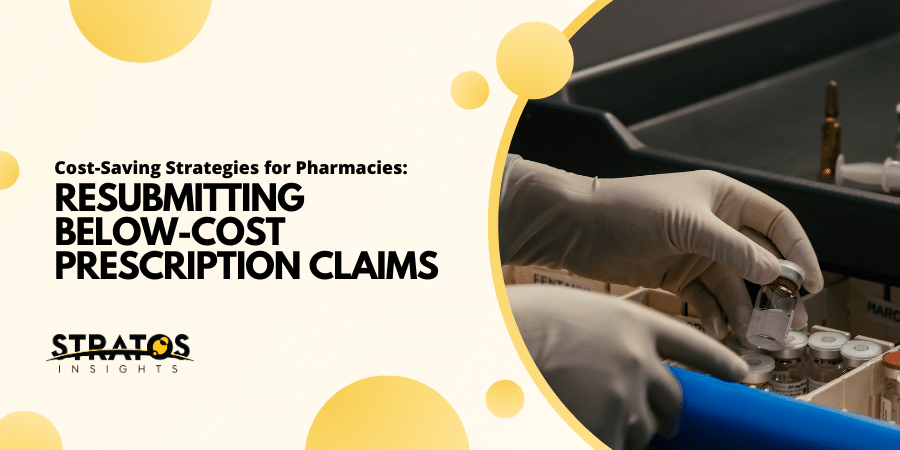The Hidden Financial Drain in Your Pharmacy
As a pharmacy owner or operator, you’re acutely aware that your business operates on razor-thin margins. Every dollar counts, and yet thousands might be slipping through your fingers each month due to below-cost prescription claims. In today’s challenging reimbursement landscape, identifying and addressing these financial drains isn’t just good business practice—it’s essential for survival.
Recent industry data suggests that the average community pharmacy loses between $40,000 and $100,000 annually due to below-cost reimbursements that go unchallenged. That’s money left on the table that could be reinvested in your business, used to hire additional staff, or simply help keep your doors open in an increasingly competitive market.
Let’s explore how you can implement similar strategies to recapture lost revenue and strengthen your pharmacy’s financial health.
Understanding Below-Cost Reimbursement
Before diving into solutions, it’s crucial to understand the problem. Below-cost reimbursement occurs when the amount you receive from a PBM or other payer falls short of your acquisition cost for the medication, not to mention the operational costs associated with dispensing.
Several factors contribute to this increasingly common scenario:
- Outdated MAC (Maximum Allowable Cost) lists that don’t reflect current market prices
- Rapid fluctuations in drug costs that outpace reimbursement updates
- PBM contract terms that don’t include timely MAC updates
- Arbitrary reimbursement formulas that bear little relation to actual costs
While many pharmacy owners feel powerless against these forces, a proactive approach to identifying and challenging below-cost reimbursements can recover significant revenue. The key lies in systematic identification, documentation, and persistence.
Creating a Systematic Identification Process
The initial step in recovering lost revenue is to establish a systematic process to identify below-cost claims. If you are part of a PSAO, it is important to know if they are appealing on your behalf for both brands and generics, whether they have loss thresholds, and which PBMs are involved. For direct PBM contracts (outside of your PSAO), submitting your own appeals to PBMs is your responsibility. Manual checks can be time-consuming and susceptible to errors, making automation important for efficiency.
Daily Claim Review Protocol
Implement a daily protocol for reviewing the previous day’s claims:
- Compare reimbursement to your true acquisition cost: Establish a reporting system that flags any prescription where reimbursement falls below acquisition cost.
- Prioritize by impact: Focus first on high-dollar claims and frequently dispensed medications, as these represent the greatest financial opportunity.
- Track patterns by payer: Document which PBMs or plans consistently provide below-cost reimbursement to identify systemic issues versus one-time problems.
Documenting Your Case
Once you’ve identified below-cost claims, proper documentation becomes your most powerful tool. PBMs often reject resubmissions without substantial evidence, so thoroughness is essential.
Critical Documentation Elements
For each below-cost claim you plan to challenge, gather:
- Original claim information: Prescription number, date of service, patient identifier, drug dispensed, quantity, and days’ supply.
- Financial breakdown: Document the exact reimbursement received, your acquisition cost (with invoice proof), dispensing fee, and the resulting net loss.
- Market data: Where applicable, include NADAC (National Average Drug Acquisition Cost) data or other market price benchmarks that support your case.
- Chronology of attempts: Keep detailed records of each communication regarding the claim, including dates, contact names, and summaries of discussions.
This documentation serves two critical purposes: it strengthens your immediate appeal and builds a historical record that may support broader contract negotiations or even potential legal action regarding systematic underpayment.
Effective Resubmission Strategies
With solid documentation in hand, you’re ready to pursue reimbursement corrections. Success often depends as much on strategy as on the merits of your case.
Timing Considerations
- Act quickly: Most PBMs have strict timeframes for appeals, typically ranging from 7 to 30 days after the initial claim. Verify your specific contract terms and establish processes that ensure you meet these deadlines.
- Batch similar claims: When possible, group related claims (same medication, same plan) to demonstrate patterns rather than isolated incidents.
- Follow up consistently: Establish a calendar for following up on outstanding appeals, as PBMs may rely on pharmacies forgetting or abandoning challenging claims.
Communication Approaches
How you frame your appeal can significantly impact your success rate:
- Focus on facts, not emotions: While below-cost reimbursements are understandably frustrating, keep communications professional and data-driven.
- Reference specific contract language: When applicable, cite the exact sections of your PBM contract that support your position.
- Escalate strategically: Begin with standard appeal channels but be prepared to escalate to state insurance boards for significant or systemic issues.
- Document all communications: Record the date, time, contact person, and outcome of every interaction regarding the claim.
Leveraging Technology for Efficiency
Managing resubmissions manually quickly becomes overwhelming, especially for high-volume pharmacies. Technology solutions can dramatically improve both identification and tracking.
Automation Opportunities
- Claim analysis software: Invest in systems that automatically flag potential below-cost claims by comparing reimbursement data with your actual acquisition costs.
- Appeal workflow management: Utilize technology that tracks appeal deadlines, documents communication history, and alerts staff to follow-up requirements.
- Performance analytics: Implement reporting that identifies patterns in below-cost reimbursements by drug, payer, or prescriber to inform targeted interventions.
The most effective pharmacy operations integrate these technologies directly into their daily workflow, making reimbursement optimization a standard operating procedure rather than an occasional project.
Building a Culture of Reimbursement Vigilance
Successful reimbursement management requires involvement from your entire team. Creating a culture where everyone understands the importance of appropriate reimbursement is crucial.
Staff Training and Empowerment
- Education on impacts: Help staff understand how below-cost reimbursements affect the pharmacy’s financial health and, ultimately, their job security.
- Clear roles and responsibilities: Define who is responsible for identifying problematic claims, gathering documentation, submitting appeals, and tracking outcomes.
- Regular performance reviews: Include reimbursement optimization metrics in regular business performance discussions to maintain focus.
- Celebration of successes: Recognize and reward staff contributions to successful appeals and reimbursement improvements.
Measuring Success and Continuous Improvement
Implementing these strategies isn’t a one-time project but an ongoing process that requires regular evaluation and refinement.
Key Performance Indicators
Track these metrics to gauge your success and identify improvement opportunities:
- Below-cost prescription percentage: Monitor the proportion of prescriptions dispensed below cost to track overall exposure.
- Appeal submission rate: Measure what percentage of eligible below-cost claims are actually appealed.
- Appeal success rate: Track the percentage of appeals that result in improved reimbursement.
- Average reimbursement increase: Calculate the average dollar improvement per successful appeal.
- Total recovered revenue: Measure the cumulative financial impact of your resubmission efforts.
- Time investment: Monitor staff time dedicated to resubmission activities to ensure the return justifies the investment.
Regular review of these metrics will help you refine your approach, focusing resources where they generate the greatest return.
Transforming Challenges into Opportunities
In today’s challenging pharmacy environment, effective management of below-cost claims represents not just a defensive measure but a strategic opportunity to improve profitability. By implementing systematic identification, thorough documentation, and persistent follow-through, you can transform a significant financial drain into a revenue recovery stream.
The most successful pharmacy operators view reimbursement optimization not as an administrative burden but as a core business function deserving of appropriate resources, technology, and management attention. Those who excel in this area gain a meaningful competitive advantage in an industry where margins continue to tighten.
How We Can Support Your Reimbursement Optimization Efforts
At Stratos Insights, we understand the challenges you face with below-cost reimbursements. Our business intelligence dashboard automatically identifies below-cost claims, track appeal status, and measure financial impact.
Our proprietary analytics can reveal patterns in reimbursement challenges, helping you make strategic decisions about contract negotiations and inventory management. With our wholesaler performance monitoring tools and contract analysis capabilities, we provide the data-driven insights you need to optimize your reimbursement strategy across all aspects of your operation.
Don’t leave money on the table through unchallenged below-cost reimbursements. Let us help you implement systematic approaches to identify, document, and successfully appeal these claims, transforming a financial drain into a revenue recovery opportunity.




